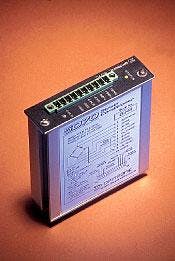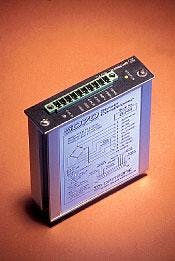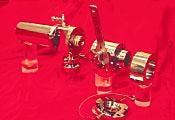New DC strain gauge conditioner module
The new Model 5D70 signal conditioner module is a single-input, dual-output, software-programmable conditioner for input of pressure, force, torque, weight, and other variables measured by conventional DC-excited strain gauge transducers.
Self-contained in an aluminum case, it can be used as an individual or in-line signal conditioner or can reside in a host device to complete an effective, economical front-end solution.
Its advanced analog design yields signal stability and accuracy over a range of sensor inputs (configurable sensitivity ranges of 0.5-16 mv/v, full scale).
Features include remotely sensed, user-selectable excitation; chopper-stabilized low-drift amplification; low-pass active filtering independently selectable for each output; 1,500 v AC isolation and high ESD immunity; internal absolute software-based calibration; external shunt calibration connections; easy-to-use configuration software; and 0.02% accuracy, full-scale (typical).
The 5D70 can provide a true average value of the measured variable, even in the face of substantial dynamic content, the firm says. Two high-level, noise-free analog outputs are provided: one is continuously available, and the other may be switched on and off by setting the logic state of an enable line (thus eliminating the need for an external multiplexer in multiple-module uses).
Source: Daytronic Corp., 2211 Arbor Blvd., Dayton, OH 45439-1521.
New drilling fluid additive
New IsoFloc 17, a potato-based drilling fluid additive, is available for use in drill-in fluid systems.
The company says the additive is compatible with all drilling fluids for temperatures up to 120° C. and has a high tolerance to monovalent and divalent salts. The low viscosity fluid loss reducer exceeds the specifications of OCMA DFCP 5 and API 13A, section 11.
Source: GCC Starch Co., c/o BETA Public Relations BV, Amaliastraat 3-5, 2514 JC Den Haag (Holland).
Sampler demounts without process interruption
A new addition to the ISOLOK family of automatic process sampling instruments features an integral process-isolation valve that allows removal of the sampler for service without depressurizing the process being sampled. New Series SAL-25 samplers handle liquids or slurries having entrained solids of major dimension up to 3/8 in. (9.5 mm), drawing measured samples of 25 cc/cycle on command from electrical or all-pneumatic controls. Actuated by a double-acting air cylinder for safety in volatile environments, samplers tap process streams moving through pipes or vessels pressurized up to 300 psi (20 bar). The sample path always remains enclosed.
A design with only one moving part, the SAL-25 mounts through an adapter hub welded onto the process equipment. The sampler body encloses a plunger that extends through the hub to penetrate the process stream then immediately withdraws. Samples are captured by positive displacement in an annular ring machined into the end of the plunger. Each 25 cc portion is drawn into the sampler body as the plunger retracts and is discharged by gravity directly into an attached container or discharge line. Custom annular rings are available for different sample sizes.
A separable section mounted between the sampler body and adapter hub contains a 11/2 in. (38.1 mm) ball-type valve that is precision-bored to allow passage of the sampler plunger. Between cycles, the plunger rests withdrawn from the valve. When the plunger is at rest, the ball can be turned to closed position, isolating the sampler body from the process. The sampler then can be detached from the isolating valve section by removing four bolts that hold the sampler and valve section together. The new design includes a special blocking cap that can be installed over the exposed isolation valve using the same four bolts, to double-block the valve outlet and to protect the valve until the sampler is reinstalled.
When the sampler's air cylinder is actuated, its 6 in. (152.4 mm) stroke extends the plunger approximately 2 in. (51 mm) into the process stream. This cleans out any materials that may have settled in the valve bore between cycles and creates local turbulence in the stream, which helps assure a representative sample.
All metal parts of the sampler are type 316 stainless steel with polished finish, and the plunger is made of tough, abrasion-resistant stainless alloy 174-PH for longer life in contact with sand, gravel, and other abrasive materials. Other metal alloys and wear-resistant nickel-tungsten-carbide bushings through the body are optionally available.
Triple O-ring seals encircling the plunger at both ends of the annular ring keep the access port closed and the process material isolated, regardless of plunger position. Product-contact seals are available in polyurethane, EPDM, DuPont Kalrez, and a variety of other materials as needed to accommodate process requirements. All seals are field-changeable.
Overall dimensions are 177/8 in. (45.4 cm) long by 6 in. deep, excluding sample collection bottle. Weight (standard construction less any accessories) is 33 lb (15 kg)
A range of cycle controls is offered, including adjustable time-based, flow-proportional, manual cycling, and programmable logic controller interface modules.
Source: Bristol Equipment Co., Box 696, Yorkville, IL 60560-0696.



